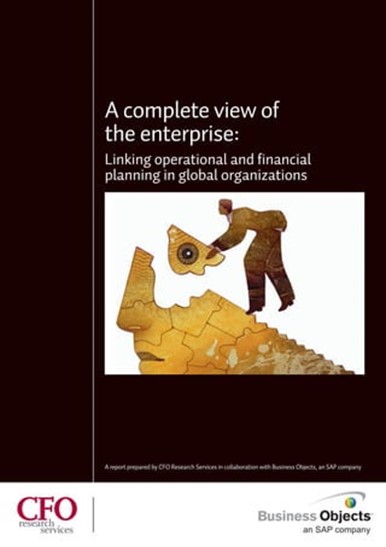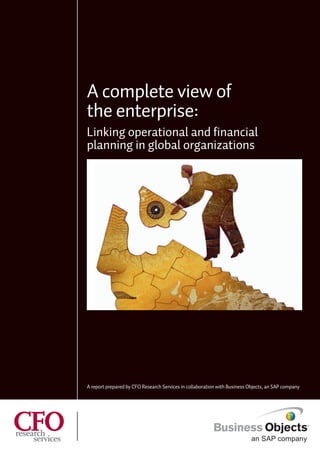A Complete View of the Enterprise

A Complete View of the Enterprise
A complete view of the enterprise: Linking operational and financial planning in global organizations

In February 2008, CFO Research Services, a unit of CFO Publishing and part of The Economist Group, began a research project with Business Objects, an SAP company, asking senior finance executives to give views on their priorities and challenges around integrating operational and financial planning processes.
The report is based on the results of an online survey of more than 400 senior finance executives in the US, UK, Germany and France, and in-depth interviews conducted with CFOs of the following companies:
• Biogen Idec
• Designed Alloy Products Inc.
• Gemalto
• Goodrich Primary Flight Control
• Hager
• Mustang Engineering
• NMHG
• Sykes
• Timken
• United Biscuits
Two confidential interviews were also conducted with a French multinational and a German consumer goods company.
CFO Research Services and Business Objects developed the scope of the research jointly. Business Objects funded the research and publication of our findings, and CFO Research Services would like to acknowledge the Business Objects team for its input and support.
CFO Research Services and Business Objects would also like to thank all the finance executives who took the time to share their valuable views with us.
CFOs, as the gatekeepers of forecasting and planning, are under pressure as never before.
Traditionally finance leaders have typically provided one view of the enterprise to their executive team and investors – the financial view – through familiar key performance indicators such as revenues, costs, cash or working capital.
Financial indicators, while crucial of course, often describe reality as it was, a historic snapshot.
Precise forecasting – explaining what is likely to happen and why – requires many different views from various departments or “lenses” within the business. Tracking non-financial operational indicators, from marketing, sales, HR or R&D, tells you what’s coming around the corner. Increasingly it falls to the finance department to make the links between forward-looking data from core operations and explain to stakeholders how this will impact on the P&L, balance sheet and cash flow statement.
But why now? What is driving the finance department to become, in essence, a hub for the integration of financial and non-financial data in forecasting and planning? There are four main factors.
First, technology has made it possible. New and improved applications offer “one version of the truth” for the CFO, a combined vision of performance management that includes linkages between financial performance and their underlying operational drivers. The functionality of these applications makes standalone spreadsheets seem obsolete by comparison.
The second reason is related to the first. As it becomes possible to see a “complete view of the enterprise” and the value of this holistic view becomes evident, many executive teams and directors have come to expect and demand it.
Third, investors and regulators are becoming more informed and sophisticated, with governments around the world adding more requirements for forward-looking analysis, and investors soliciting more detailed information on operational and reputation risks that will affect the bottom line and the value of their investment.
In the European Union, for example, the recently implemented Accounts Modernization Directive requires companies in the region to produce a “director’s report” covering both the future risks a company faces and analysis of key non-financial and financial performance indicators.
Linking operational with financial planning is therefore essential if companies are to meet new reporting requirements efficiently and effectively.
Finally, in times of economic uncertainty, companies are insisting that CFOs lead the effort to make their operational and financial planning more agile, detailed, reliable and efficient.
This research was commissioned to understand how CFOs are responding to these pressures. How integrated are operational and financial planning systems and processes today? Are CFOs satisfied with their planning processes? What planning tools are proving most effective – and what tools are falling short of expectations? What steps have CFOs taken and what are the benefits of integration for those who’ve already achieved it?
Overall, integration of financial and non-financial planning remains elusive for most CFOs in the survey, as many rely on spreadsheets, rather than applications that offer a complete view of the business.
The research, however, provides evidence that more CFOs should consider making the investment. In the survey, for example, there are clear differences in satisfaction between those who integrate operational and financial planning and those who don’t. Moreover, the CFOs who were interviewed in depth are clear about the tangible benefits that integrations brings.
Planning remains fragmented, and this is causing dissatisfaction Just one in five CFOs surveyed said that their planning processes were “highly integrated”. A similar number said operational and financial planning is conducted on the same system at their company.
Most organizations employ a patchwork of planning tools, from CRM systems to Excel spreadsheets. It’s no wonder then, that just one in 10 are “highly satisfied” with their operational
planning tools.
Spreadsheets reign, yet satisfaction is low. Spreadsheets are the most widespread tool used for all types of operational and financial planning activity, yet satisfaction with tools is highest among those using packaged applications, not spreadsheets. Also, tellingly, the use of spreadsheets is highest in the US, where satisfaction levels are lowest; spreadsheet use is lowest in Germany, where satisfaction levels are highest.
Six key findings:
Increased planning accuracy is the number one goal Planning accuracy is the top priority on CFOs performance management agenda. This could be a reflection of the times in which global economic uncertainty, credit risk, and rising commodity and raw materials prices all combine to make planning more difficult and more important.
CFOs know that in a volatile business environment, investors and executive teams will rely on them even more than usual to provide accurate, evidence-based forecasts on a more frequent basis.
When it comes to planning tools, the number one priority for respondents is “planning, reporting and analysis in one system” Having planning, reporting and analysis in a single system ranked the highest, although ease of use for nonfinancial users and driver-based modeling functionality were also important, according to respondents.
Forecasting processes are time-consuming and cumbersome. A quarter of CFOs described their company’s planning processes as “streamlined”, and almost 40% called their processes “time-consuming”. Just 2% of CFOs strongly agreed that “performing an enterprise-wide, bottom-up reforecast is a quick and easy process.”
CFOs see process change and the level of monetary investment required as the barriers to integrated planning. But tangible benefits wait for companies that take advantage The process changes and costs involved in improving links between operational and financial planning, plus the distraction of other business projects, are the biggest hurdles facing firm’s striving for greater integration between operational and financial planning.
Yet the survey and in-depth interviews show that companies who overcome challenges see tangible and lasting returns.
READ MUCH MORE INSIDE

Click on the Blue Button Below for Instant Access!
Regards, Coyalita
Behavioral Health Rehabilitative Specialist & Addiction Counselor
Copyright © 2021-2023 Thresholdlivecoyalita.com All Rights Reserved Privacy Policy – Earnings Disclaimer – Terms of Use – Contact Us




